For the first time ever, PFF has released a preseason Draft Guide highlighting all of the draft-eligible names to know heading into the 2017 season. Here is a sneak peek at the guide as we rank the top five draft-eligible players by position. The PFF Draft Guide is available as part of PFF Edge, along with our award-winning fantasy football analysis, NFL Player Grades, and much more.
Quarterback
Sam Darnold, USC
The Good: Outstanding throwing in the middle of the field where he posted the third-best grade in the nation in 2016.
Room to Improve: Floats the deep ball far too often and graded at 46th out of 116 qualifiers on 20-plus yard passes in 2016.
Josh Rosen, UCLA
The Good: Has the ability to process quickly and work though full-field progressions. Ranked fourth in the draft class with an adjusted completion percentage of 76.3 percent against the blitz.
Room to Improve: Has to make better decisions, either taking the easy completion or when extending the play outside the pocket. Had the 21st highest percentage of turnover-worthy throws in 2016.
Mason Rudolph, Oklahoma State
The Good: Accurate throwing at the intermediate and deep levels, with a particularly good feel for throwing the deep out/comeback and throwing catchable passes along the sideline.
Room to Improve: Misses too many short-area throws and ranked 37th in the draft class with an adjusted completion percentage of 71.2 percent on 6-10 yard throws.
Luke Falk, Washington State
The Good: Accurate short-area thrower with good touch for downfield throws. Ranked third in the draft class with an adjusted completion percentage of 78.0 percent in 2016.
Room to Improve: Needs to show more zip when throwing outside the numbers and he can improve his accuracy at the intermediate (11-20 yard) level where his adjusted completion percentage of 61.9 percent ranked 22nd in the draft class.
Baker Mayfield, Oklahoma
The Good: Excellent accuracy to all levels of the field and led the draft class with an adjusted completion percentage of 79.8 percent, including a 67.6 percent mark under pressure that ranked third in 2016. 93.5 overall grade led the nation in last season.
Room to Improve: Will have to show that he can still produce despite the loss of Biletnikoff Award winner Dede Westbrook. Can improve his accuracy on over-the-shoulder throws.
Running Back
Saquon Barkley, Penn State
The Good: Big-play threat ranking third among draft-eligible running backs with 9.8 percent of his runs going for explosive (15-plus yard) plays in 2016.
Room to Improve: 23.2 percent of carries went for no gain or negative yardage, fifth highest among draft-eligible running backs
Derrius Guice, LSU
The Good: 12.9 percent of carries went for 15-plus yards, best among draft-eligible running backs and 32.8 percent of carries went for either a first down or a touchdown, sixth best in the class.
Room to Improve: Has only 19 targets in his two years, so there’s more to see from him in the pass game. Pass blocking efficiency of 94.3 ranked 65th in the draft class.
Nick Chubb, Georgia
The Good: Maximizes what the run blocking gives him, picks up yards through contact, and finished third in the nation with an elusive rating of 113.3 as a true freshman in 2014.
Room to Improve: Production has decreased as he forced a missed tackle once every 3.6 carries in 2014 and 2015, but only one every 5.7 carries in 2016. Can he put together an injury-free, dominant 2017?
Royce Freeman, Oregon
The Good: Impressive size/speed combination and finished with an elusive rating of 108.6 in 2015, tied for fifth in the nation.
Room to Improve: Disappointing 2016 marred by injury and fewer carries, can he bounce back. 20.9 percent of his carries with for no gain or negative yardage, 14th highest among draft-eligible running backs last season.
Bo Scarbrough, Alabama
The Good: Elusive rating of 147.3 ranked third in the nation. Forced 40 missed tackles on only 125 rushes.
Room to Improve: Ball security must improve as he had three fumbles on only 132 touches in 2016.
Wide Receiver
Courtland Sutton, SMU
The Good: Huge frame and large catch radius allow him to succeed in contested situations. Gained 574 yards on deep passes in 2016, fifth highest in the draft class.
Room to Improve: Can run crisper routes and has room to improve as a blocker.
James Washington, Oklahoma State
The Good: Deep threat who maintains his speed in and out of his cuts. Led the draft class with 690 yards on deep passes in 2016 while ranking ninth with 2.92 yards per route.
Room to Improve: Needs to be more consistent at the catch point in contested situations and has 18 drops in his three years (drop rate of 8.97 percent ranked 85th in the draft class in 2016).
Calvin Ridley, Alabama
The Good: Has the speed to make plays down the field. Has 11 catches of 40-plus yards over the last two years, and would likely be even more with better quarterback play.
Room to Improve: Dropped 16 passes in his two years including a drop percentage of 11.11 percent that ranked 109th in the draft class in 2016.
Deebo Samuel, South Carolina
The Good: Can win down the field, caught 55.6 percent of deep (20-plus yard) passes (10th best in the nation in 2016). He’s also excellent after the catch, forcing a missed tackle on 26.7 percent of his targets, fifth best among draft-eligible receivers with at least 50 receptions last season.
Room to Improve: Could stand to be more physical at the catch point in contested situations.
Antonio Callaway, Florida
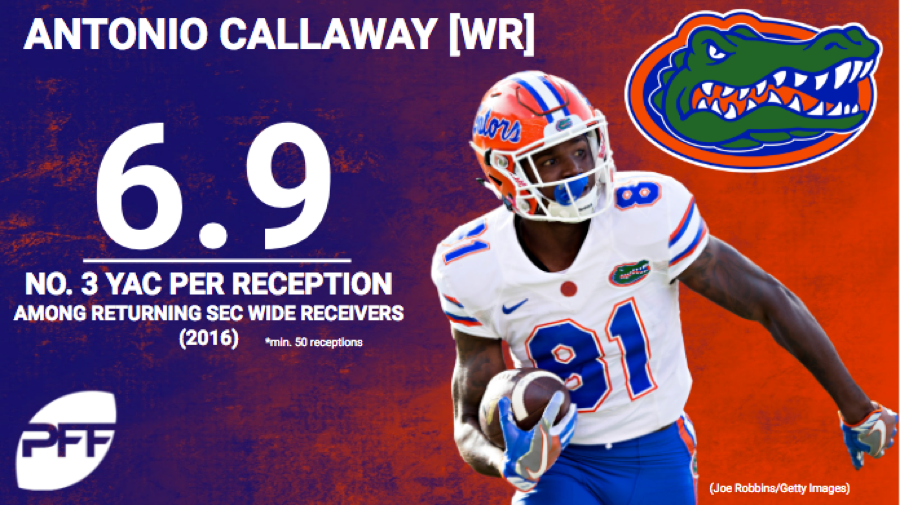
The Good: Has the speed to get behind the defense and create big plays on short passes. Has averaged 7.3 yards after the catch per reception in his two years.
Room to Improve: Multiple off-field incidents are a concern. Dropped 10-of-99 catchable passes (10.1 percent) over the last two years.
Tight End
Dallas Goedert, South Dakota
The Good: Great ball skills and catch radius. Good athlete who has produced at the FCS level and when given opportunity against FBS competition.
Room to Improve: Can improve his run blocking where his top grade in a limited sample is his 66.3 grade in 2015.
Troy Fumagalli, Wisconsin
The Good: Has a good catch radius and makes plays at all levels of the field. Ranked second in the draft class with five deep (20-plus yard) catches in 2016.
Room to Improve: Improve as a run blocker in 2016, but still has work to do when matched up against defensive ends.
Mark Andrews, Oklahoma
The Good: Good size and speed have led to an average of 16.1 yards per reception in his two years.
Room to Improve: Can do a better job of adjusting to off-target passes and his blocking is a question mark as he only has 170 career snaps as an in-line tight end.
Adam Breneman, UMass
The Good: Sure-handed tight end posted the nation’s top receiving grade in 2016 at 90.6 while dropping only two of his 72 catchable passes.
Room to Improve: Ranked only 139th as a run blocker and finished with the sixth lowest percentage of positively-graded blocks in the draft class.
C.J. Conrad, Kentucky
The Good: Gets upfield quickly after the catch and his 8.8 yards after the catch per reception ranked fourth best in the draft class among tight ends with at least 10 catches.
Room to Improve: Can do a better job of adjusting to off-target throws and can cut down on his four career drops on only 38 catchable passes.
Offensive Tackle
Connor Williams, Texas
The Good: Outstanding second-level run blocker who finished with the third-highest percentage of positively-graded run blocks in the draft class in 2016.
Room to Improve: Third scheme in as many years will test his productivity. Needs to show that last year’s run blocking improvement was more than just a favorable scheme.
Orlando Brown, Oklahoma
The Good: Large frame to move defenders both in-line and at the second level in the running game. Ranked fifth in the draft class with a pass blocking efficiency (PBE) of 98.9.
Room to Improve: Ranked only 40th in the draft class at avoiding negatively-graded blocks in the run game in 2016.
Mike McGlinchey, Notre Dame
The Good: Powerful run blocker who finished with the second highest percentage of positively-graded run blocks in 2016.
Room to Improve: Has yet to be dominant in pass protection where his pass blocking efficiency (PBE) of 97.0 ranked 399th in the draft class.
Tariq Cole, Rutgers
The Good: Good length for pass protection and did a fine job against inside moves where he allowed only one inside pressure every 175.5 rushes, 16th best in the draft class.
Room to Improve: Ranked only 68th in the draft class at avoiding negatively-graded blocks in the run game in 2016.
Brian O’Neill, Pittsburgh
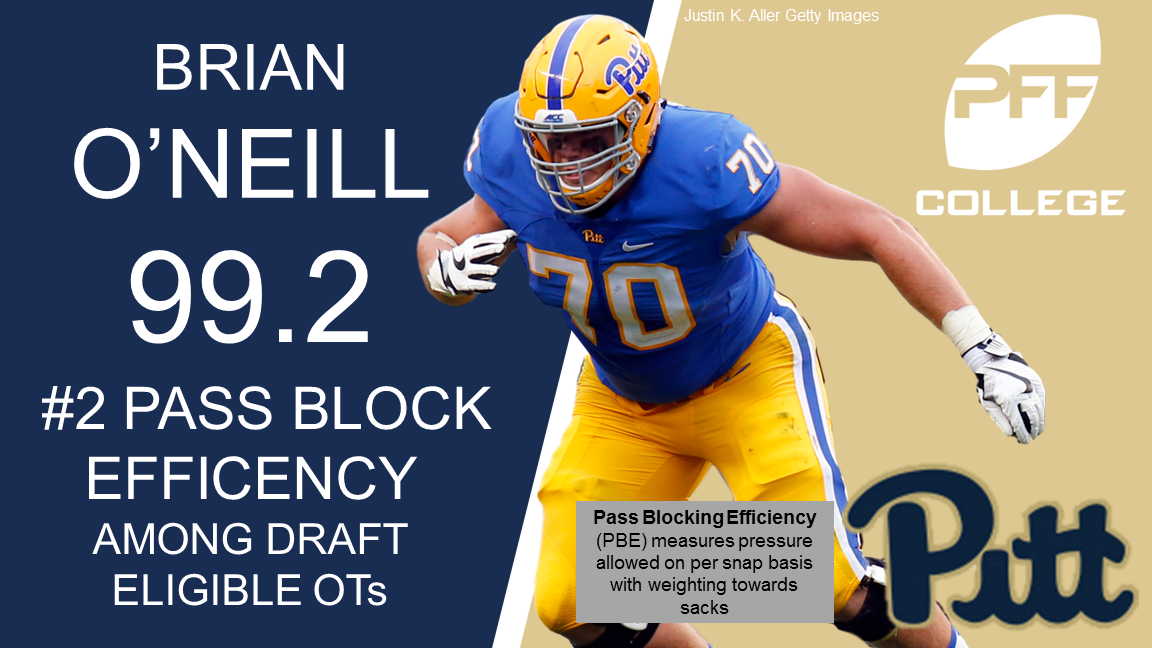
The Good: Played in an O-Line-friendly scheme, but allowed only four total pressures on 390 attempts in 2016 (pass blocking efficiency of 99.2 ranked second in the draft class).
Room to Improve: Ranked only 72nd in the draft class in positively-graded blocks last season.
Interior Offensive Line
Quenton Nelson, G, Notre Dame
The Good: Effective both in-line and on the move as a run blocker. Had the fifth highest percentage of positively-graded run blocks in the draft class last season.
Room to Improve: Took strides as a pass protector in 2016, but still more work to be done after ranking 28th in the draft class with a pass blocking efficiency of 98.1.
Frank Ragnow, G/C, Arkansas
The Good: Had the second-highest percentage of positively-graded blocks and the lowest percentage of negatively-graded blocks in the run game among draft-eligible centers in 2016.
Room to Improve: Can take another step forward in pass protection where his pass blocking efficiency of 97.4 on 7-step drops ranked 28th in the draft class.
Bradley Bozeman, C, Alabama
The Good: Rarely off balance in the run game and had the fourth-lowest percentage of negatively-graded blocks in the draft class last season.
Room to Improve: Run blocking grade tapered off down the stretch so would like to see him be more consistent from start to finish in 2017.
Will Hernandez, G, UTEP
The Good: Strong at the point of attack, Hernandez led all guards with a pass blocking efficiency of 99.8 last year while also picking up the lowest percentage of negatively-graded run blocks in the draft class last season.
Room to Improve: Worst game of 2016 came against Texas, so his games against FBS competition in 2017 (Oklahoma and Arizona) will be crucial for his evaluation.
Wyatt Teller, G, Virginia Tech
The Good: Mauling run blocker who had the fourth lowest percentage of negatively-graded run blocks in the draft class and has three strong years of run block grades.
Room to Improve: Has committed 19 penalties in three years including eight in 2015, 13th most in the nation.
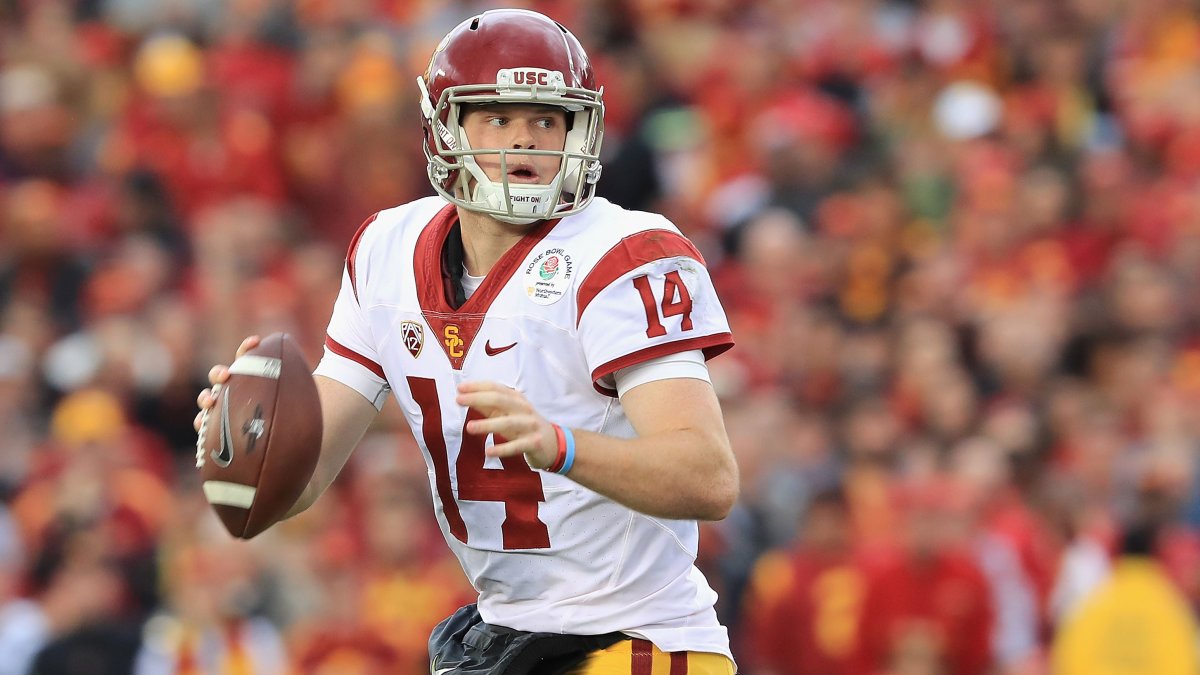



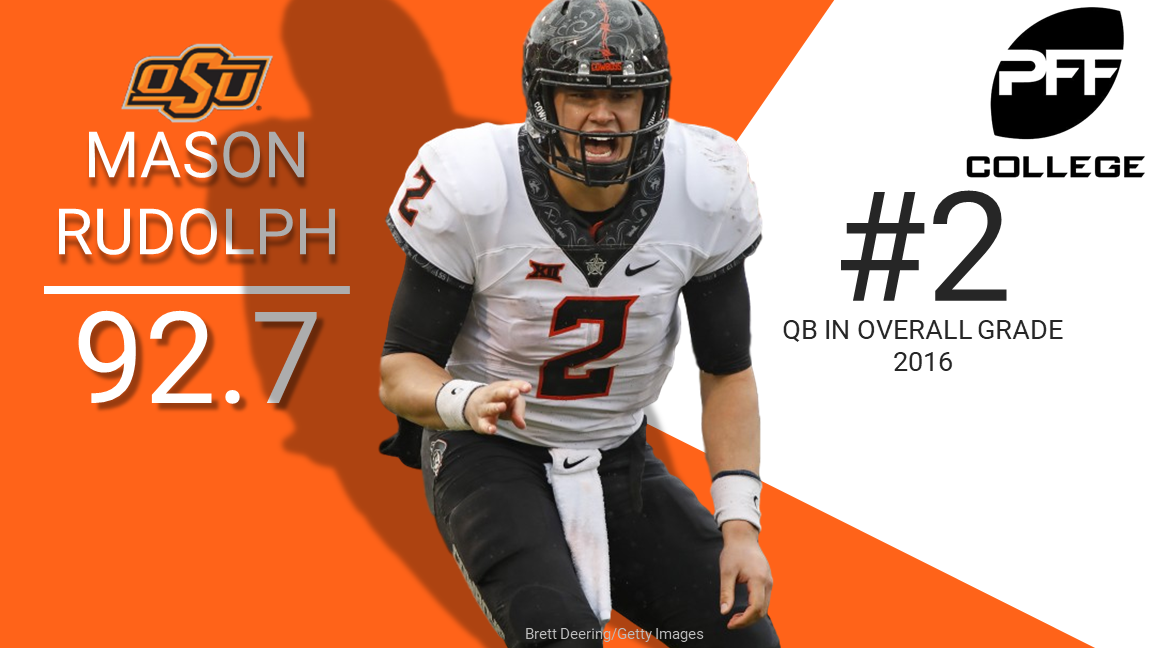
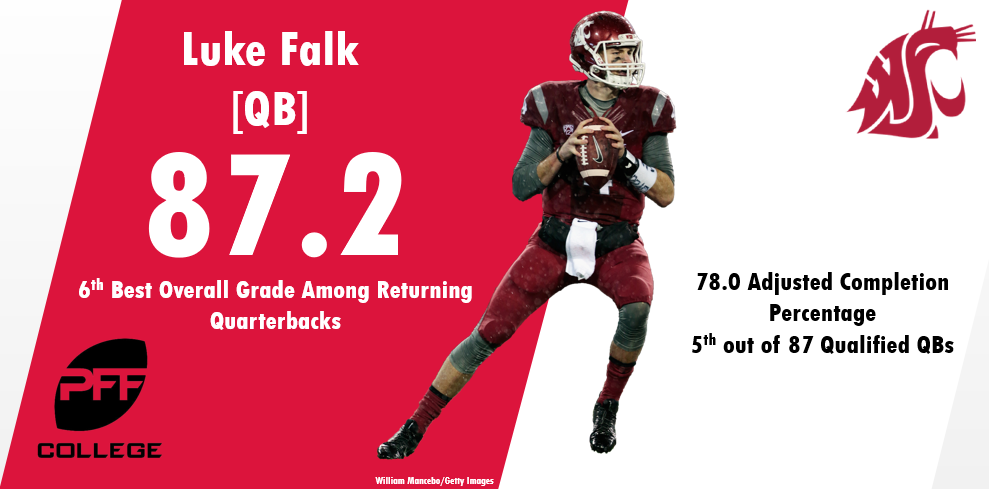
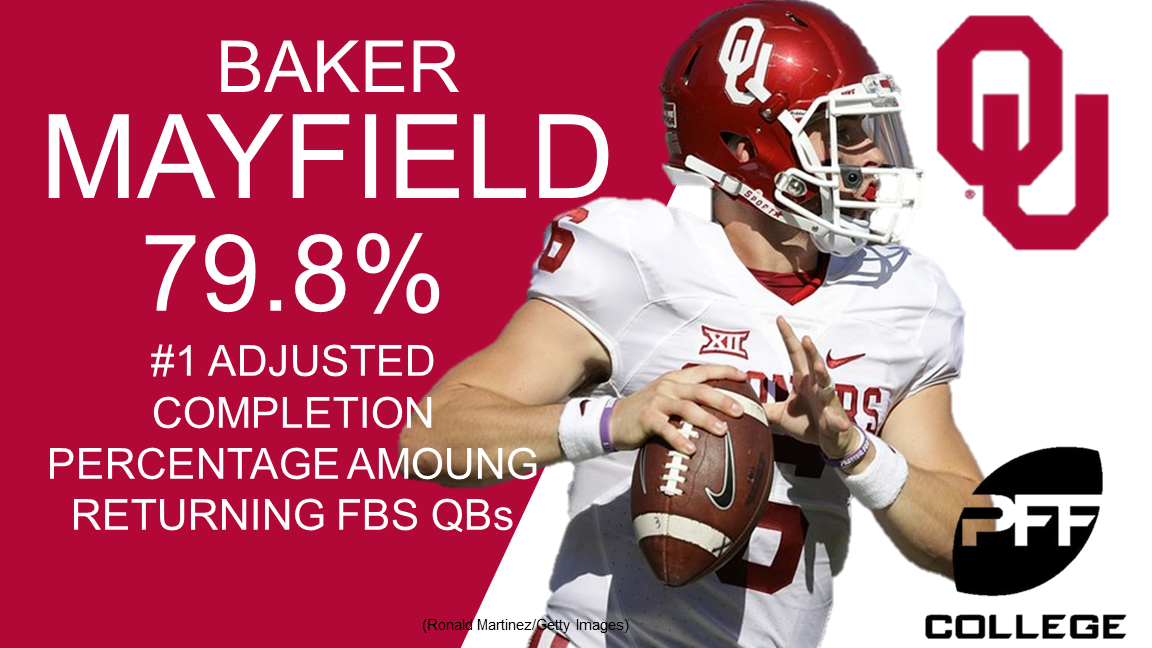
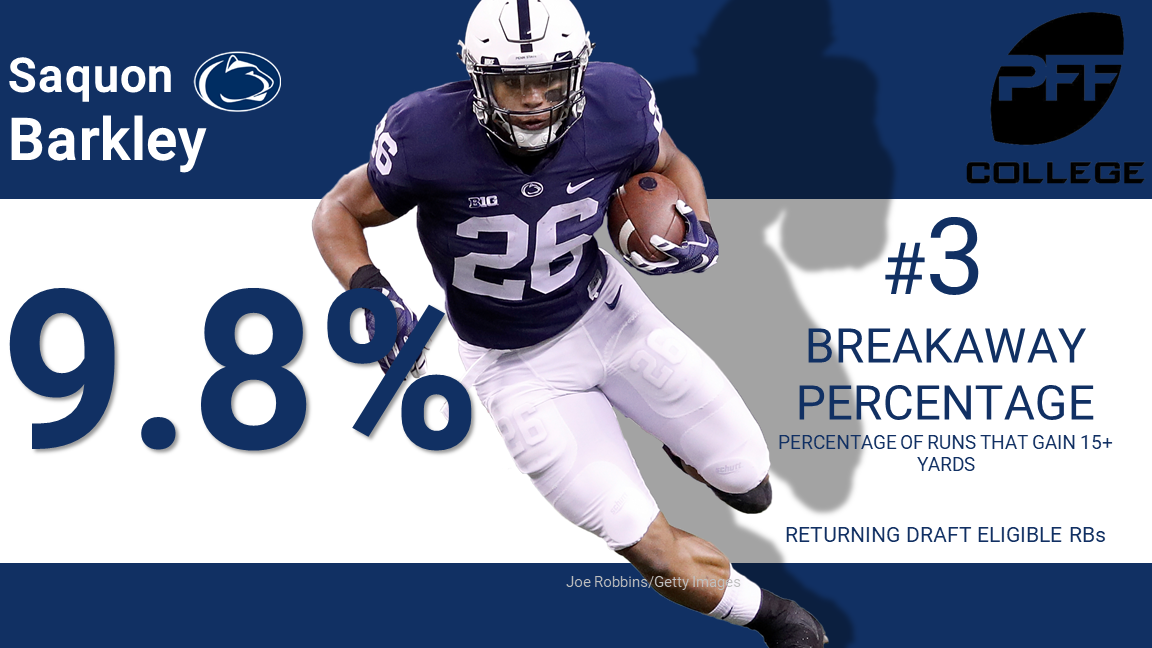
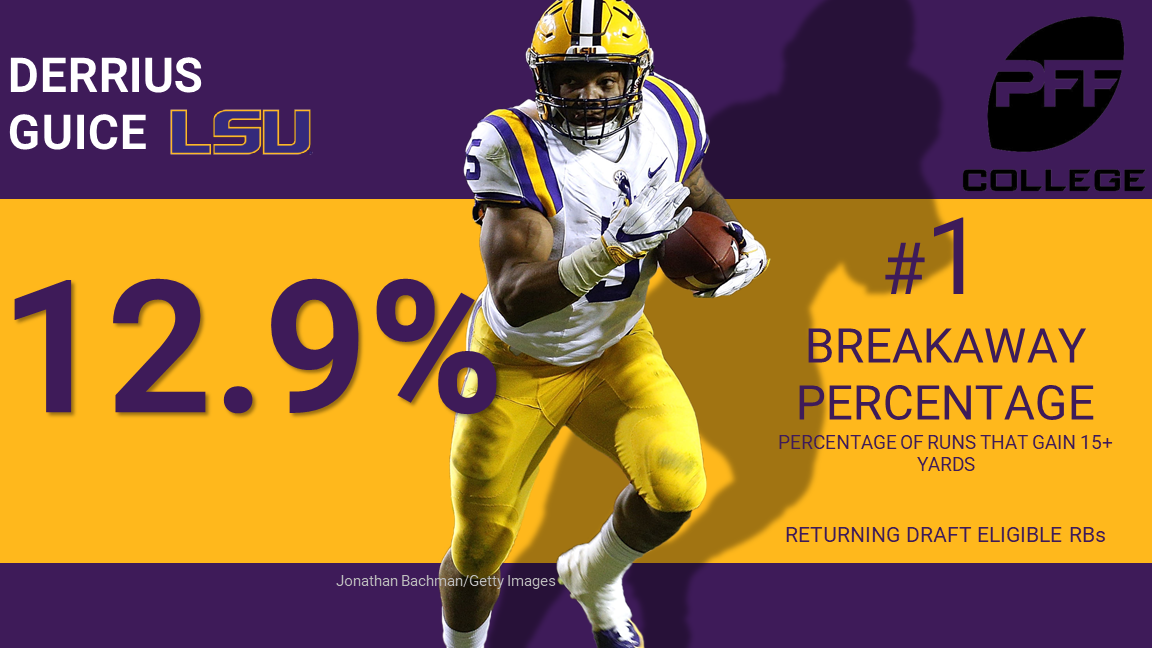

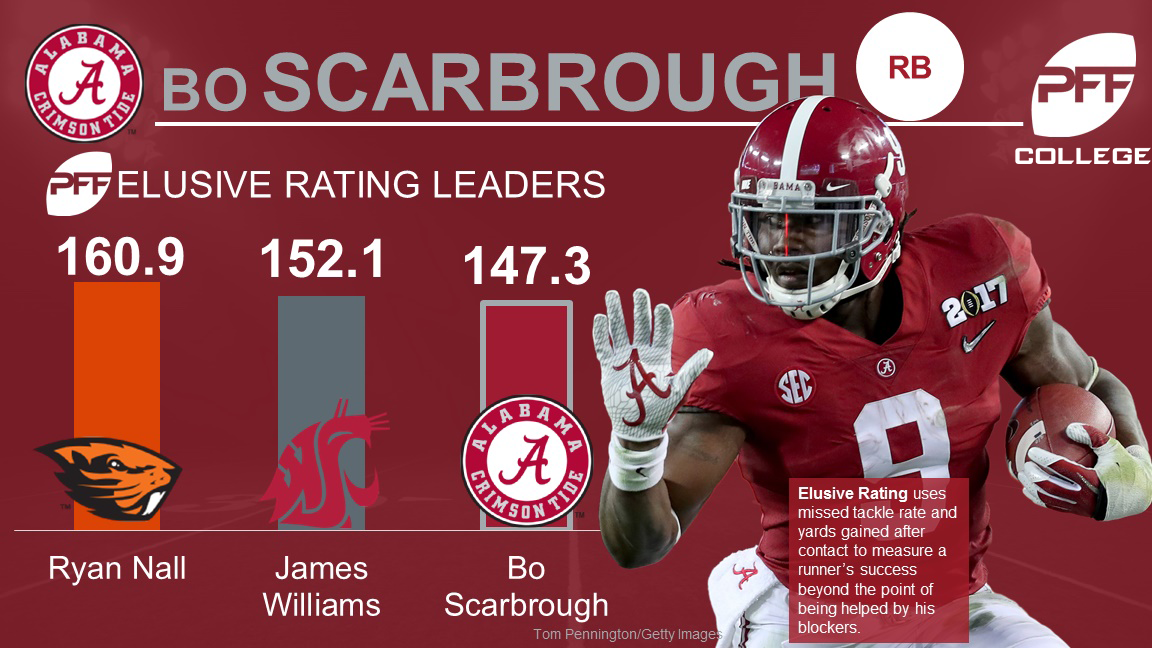
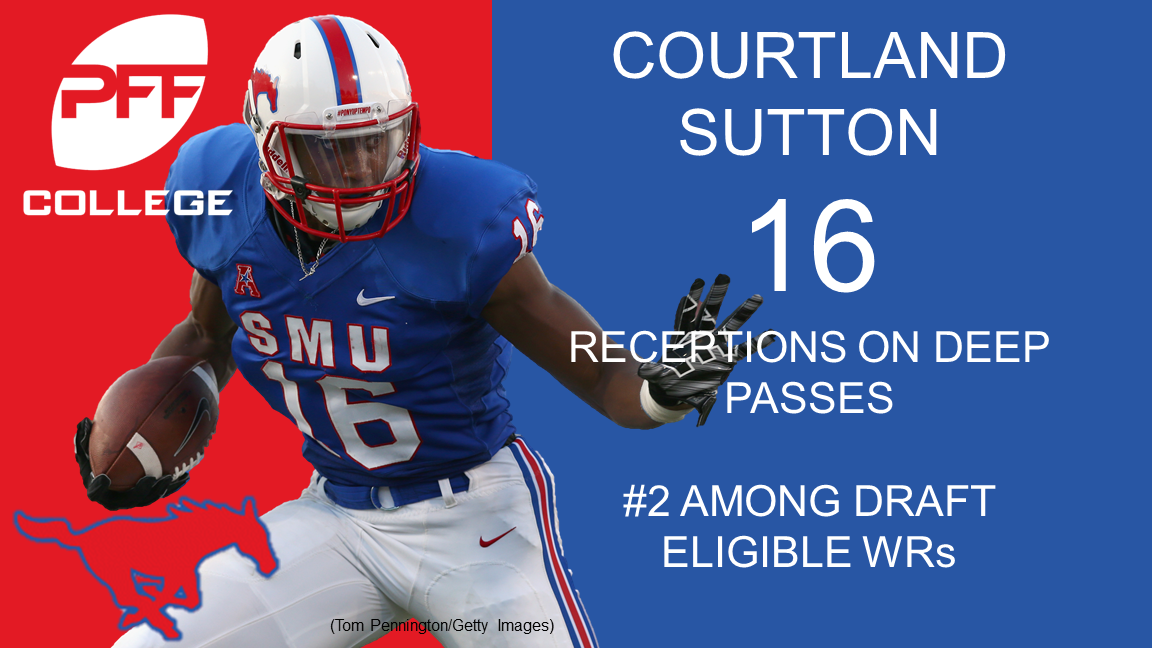
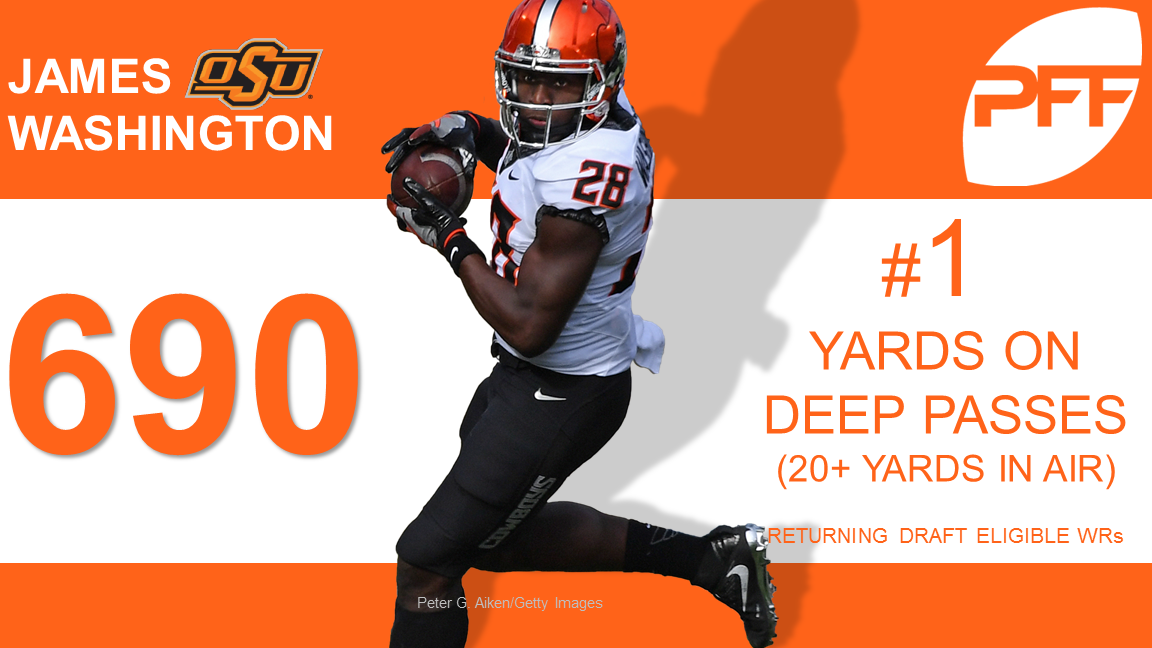
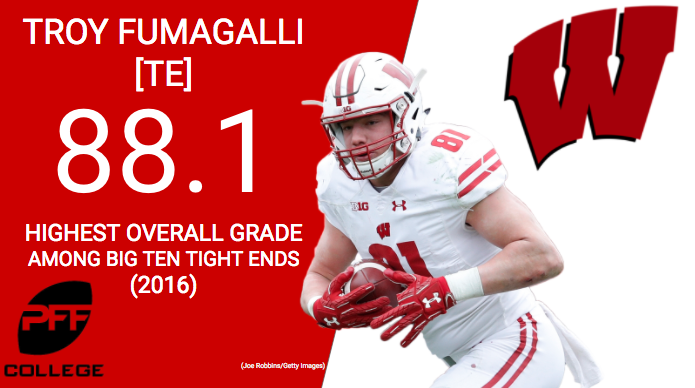
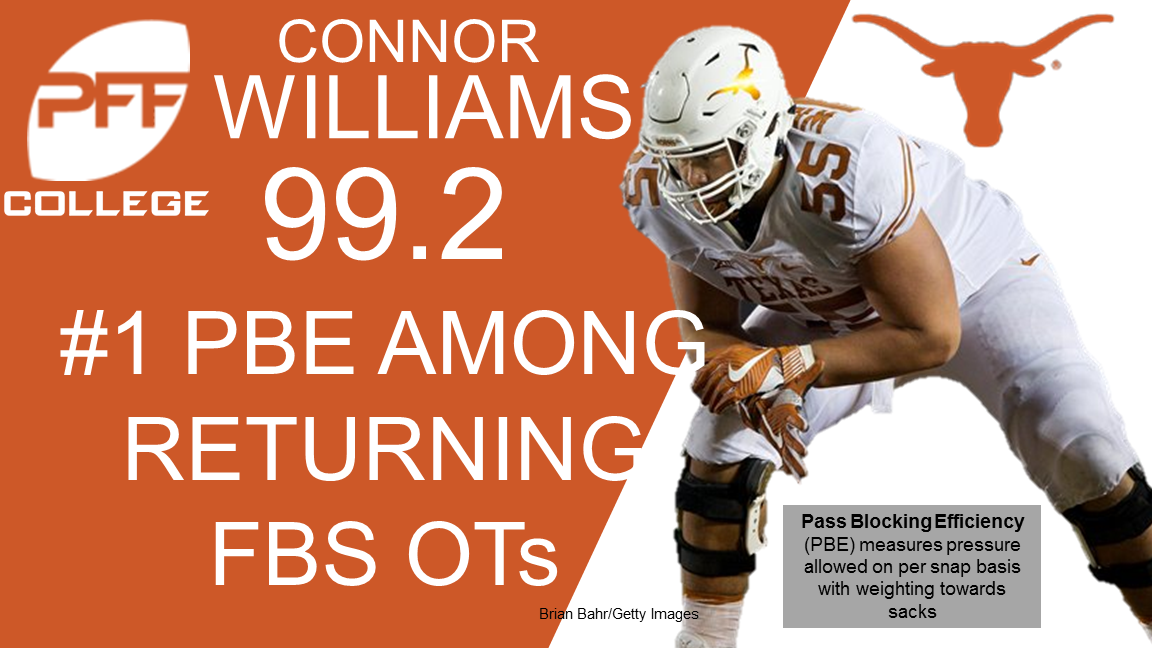
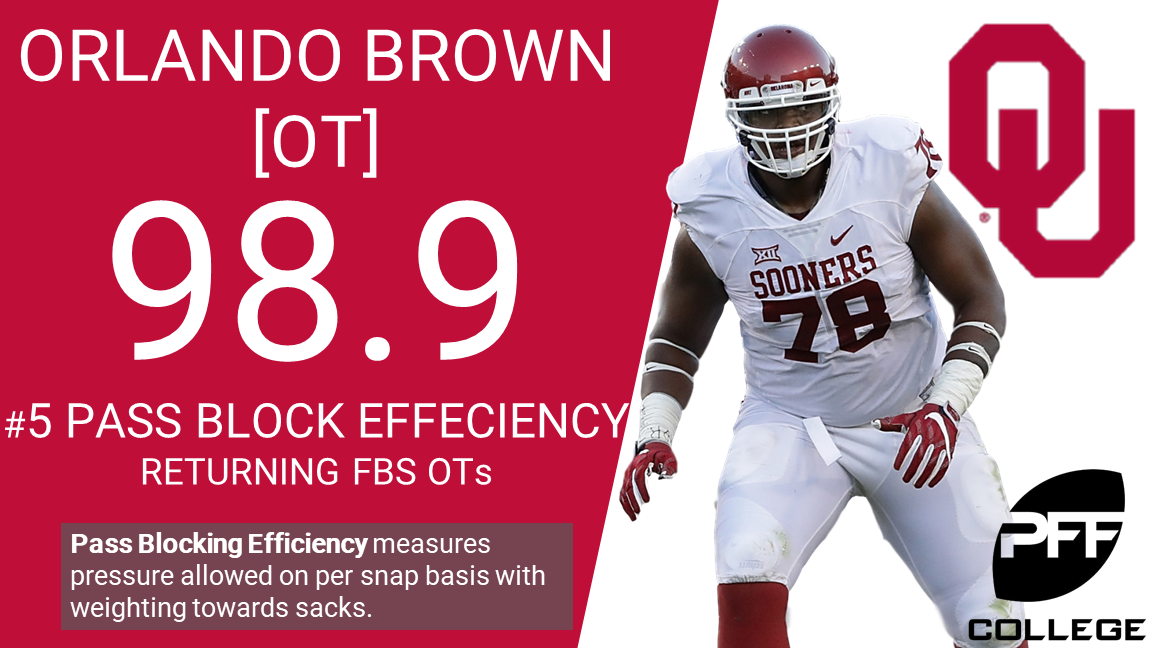
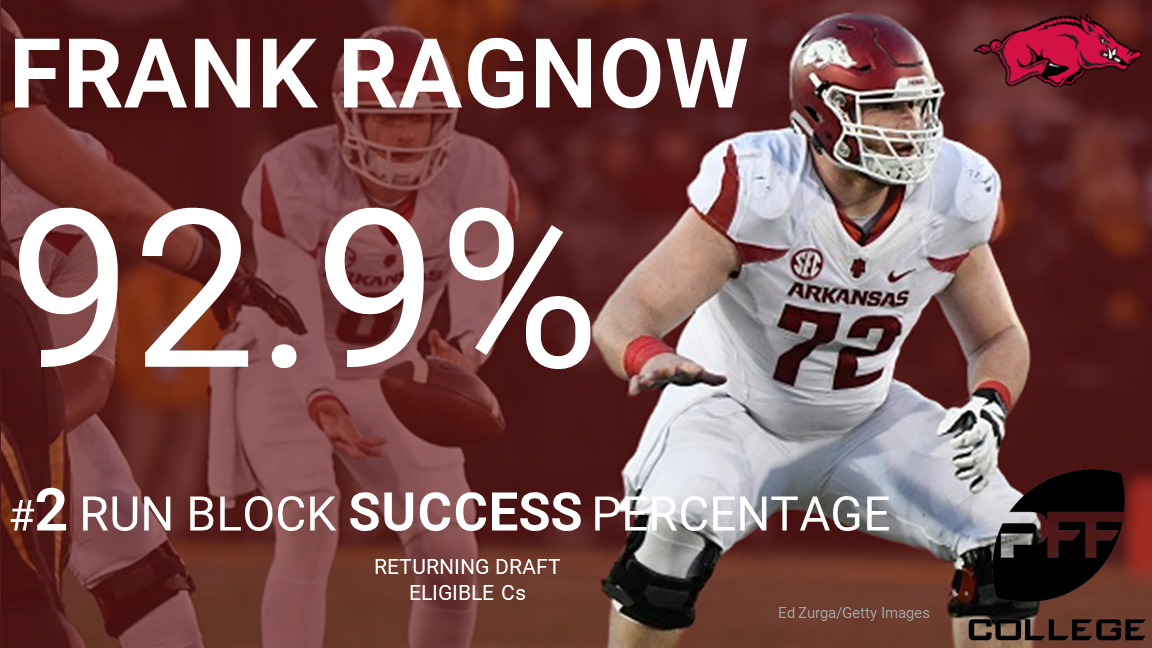
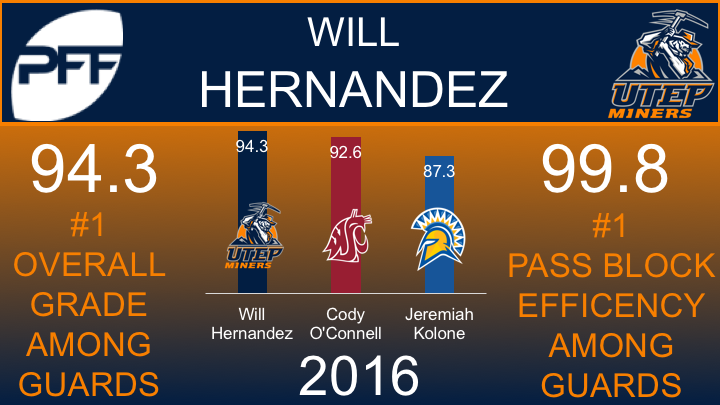
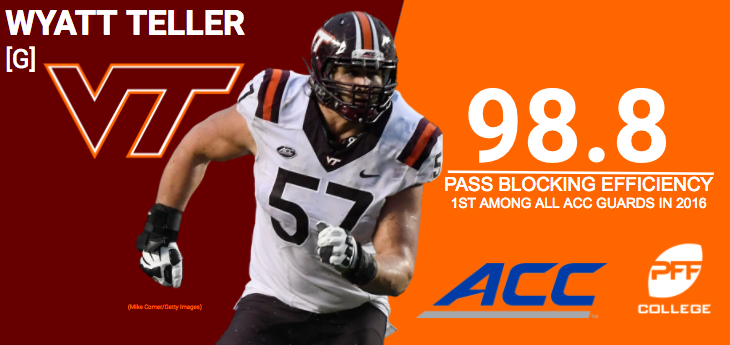


 © 2024 PFF - all rights reserved.
© 2024 PFF - all rights reserved.